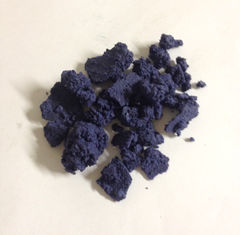Difference between revisions of "Chromium(III) sulfate"
(Added image) |
|||
| Line 1: | Line 1: | ||
[[File:Chromium(III) sulfate.jpg|thumb|240px]] | [[File:Chromium(III) sulfate.jpg|thumb|240px]] | ||
| − | '''Chromium(III) sulfate''' is the inorganic compound with chemical formula Cr<sub>2</sub>(SO<sub>4</sub>)<sub>3</sub>. It is a temperature-sensitive blue-grey solid and one of the principal compounds of [[chromium]]. | + | '''Chromium(III) sulfate''' is the inorganic compound with chemical formula '''Cr<sub>2</sub>(SO<sub>4</sub>)<sub>3</sub>'''. It is a temperature-sensitive blue-grey solid and one of the principal compounds of [[chromium]]. |
==Properties== | ==Properties== | ||
===Chemical=== | ===Chemical=== | ||
| − | |||
Solutions of chromium(III) sulfate turn from blue to green upon heating, indicating the formation of a less reactive "sulfato-complex" that may take days or weeks to revert. Freshly prepared chromium sulfate often contains traces of this coloration, with some samples even appearing green rather than blue, but is otherwise usable. | Solutions of chromium(III) sulfate turn from blue to green upon heating, indicating the formation of a less reactive "sulfato-complex" that may take days or weeks to revert. Freshly prepared chromium sulfate often contains traces of this coloration, with some samples even appearing green rather than blue, but is otherwise usable. | ||
| Line 43: | Line 42: | ||
===Relevant Sciencemadness threads=== | ===Relevant Sciencemadness threads=== | ||
*[http://www.sciencemadness.org/talk/viewthread.php?tid=14430 Chromium alum crystallisation problem] | *[http://www.sciencemadness.org/talk/viewthread.php?tid=14430 Chromium alum crystallisation problem] | ||
| + | |||
[[Category:Chemical compounds]] | [[Category:Chemical compounds]] | ||
[[Category:Inorganic compounds]] | [[Category:Inorganic compounds]] | ||
[[Category:Chromium compounds]] | [[Category:Chromium compounds]] | ||
[[Category:Sulfates]] | [[Category:Sulfates]] | ||
Revision as of 17:09, 9 May 2016
Chromium(III) sulfate is the inorganic compound with chemical formula Cr2(SO4)3. It is a temperature-sensitive blue-grey solid and one of the principal compounds of chromium.
Contents
Properties
Chemical
Solutions of chromium(III) sulfate turn from blue to green upon heating, indicating the formation of a less reactive "sulfato-complex" that may take days or weeks to revert. Freshly prepared chromium sulfate often contains traces of this coloration, with some samples even appearing green rather than blue, but is otherwise usable.
A solution of both chromium(III) sulfate and potassium sulfate will yield crystals of chrome alum on partial evaporation.
Treatment of chromium(III) sulfate with bases produces chromium(III) hydroxide. If the base used is a carbonate or bicarbonate, this reaction is accompanied with the release of carbon dioxide, in a manner similar to iron, which does not form carbonates.
Strong oxidizers such as hypochlorite can oxidise the aqueous Cr(III) to chromate (CrO42-).
Physical
Chromium(III) sulfate most often appears as a blue-grey or violet-grey amorphous solid. Recently prepared samples or those that have been subjected to heat may contain a deep green-colored sulfato complex and are hygroscopic as a result. Purer samples can be dried to form a lighter-colored powder.
Chromium(III) sulfate is readily soluble in water and some lower alcohols.
Availability
Chromium sulfate, for the most part, can only be purchased from online suppliers. Its use as a tanning chemical has largely been superseded by chrome alum and other agents.
Preparation
The Jones oxidation, which uses a solution of potassium dichromate or sodium dichromate acidified with sulfuric acid to oxidize alcohols, produces chromium(III) sulfate as a byproduct, along with sodium or potassium sulfate. If the temperature of the reaction is kept low enough, the presence of chromium(III) sulfate will be indicated by a blue or blue-violet color to the end product, rather than a green color produced when the temperature is too high. To extract the chromium(III) from solution, the reaction products must be treated with bases to precipitate chromium(III) hydroxide.
Chromium(III) sulfate can be more directly produced by the action of cold, dilute sulfuric acid on chromium(III) hydroxide or chromium(III) oxide. It should be noted, however, that many grades of chromium(III) oxide are not reactive enough, often as a result of being calcined, to respond to treatment with acid.
Projects
- Grow crystals of chrome alum, a double salt
Handling
Safety
Contact with solutions of chromium(III) sulfate or inhalation of particles may cause irritation, but overall this compound is relatively non-toxic.
Storage
Chromium(III) sulfate is relatively stable and unreactive, but should be kept away from temperatures greater than 40 °C when in the presence of moisture to avoid complex formation.
Disposal
Chromium(III) can be harmful to marine life, so water-soluble compounds of trivalent chromium should be precipitated as chromium(III) hydroxide before being disposed of in the trash.
